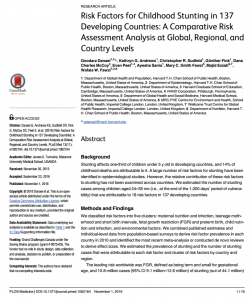
Why Was This Study Done?
- Even though child mortality is decreasing, children around the world are still suffering from delayed physical growth. In fact, 30% of children in developing countries are stunted (i.e., have heights more than two standard deviations below the globalstandard median height for their age).
- The first 1,000 days of life (up until a child turns two) are most important because development during this period impacts a child for the rest of his or her life. Stunting during this period is related to poor outcomes in health, cognitive development, and educational and economic attainment later in life.
- In order to reduce stunting, it is important to understand its determinants and their relative effect, to help priority-setting in designing policiesto improve childhood growth.
What Did the Researchers Do and Find?
- We identified 18 key risk factors for stunting and grouped them into five clusters (maternal nutrition and infection, teenage motherhood and short birth intervals, fetal growth restriction and preterm birth, child nutrition and infection, and environmental factors).
- We used data on the prevalence of each risk factor in each country and its effect on stunting. We then estimated the prevalence and number of cases of stunting among children aged 24 to 35 months in 2010 that were attributable to each of these risk factors, and to each cluster of risk factors combined, in 137 developing countries.
- We found that the leading risk for stunting worldwide was being “term, and small for gestational age” (that is, being born at or after 37 weeks of pregnancy, but being too small), to which 10.8 million cases of stunting among two-year-olds were attributable (out of 44.1 million). This was followed by poor sanitation (7.2 million cases) and diarrhea (5.8 million cases).
- When we grouped the risks together, fetal growth restriction and preterm birth was the leading risk factor cluster in all regions, but there were differences in the ranking of other risk factor clusters across regions. For example, environmental risk factors (i.e., poor water quality, poor sanitary conditions, and use of solid fuels) had the second largest impact on stunting globally and in South Asia, sub-Saharan Africa, and East Asia and Pacific, whereas risk factors related to child nutrition and infection were the second leading risk factors in other regions.
What Do These Findings Mean?
- Efforts to further reduce stunting should be focused on fetal growth restriction and poor sanitation, and this will require refocusing prevention programs on interventions that reach mothers and families and improve their living environment and nutrition.